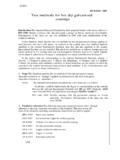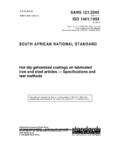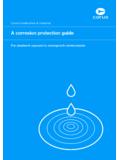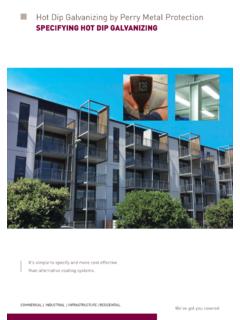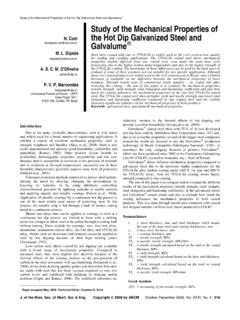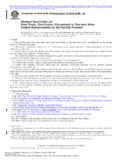Transcription of Advisory Note - National Galvanising Industries
1 Page 1 of 4 Level 5, 124 Exhibition Street, Melbourne, Victoria 3000, Australia T: +613 9654 1266 | F: +613 9654 1136 E: | W: Advisory Note GEN 7/2 Repair of Field Welds on Hot Dip Galvanizing December 2013 Introduction Ideally, the design and build phase of a structure should allow for only the minimum of on-site rectification works. By minimising or eliminating field work, the risk of early corrosion of steelwork is reduced, especially in medium to high corrosivity zones. However, there are times when field welding is a necessary activity and this Advisory Note provides general information on the repair of hot dip galvanized steel after on-site or field welding has been carried out.
2 Weld damage When severe damage to the galvanized coating has occurred during welding, protection of the steelwork must be restored. The level and extent of the restoration must be more robust and the repair work completed prior to the article being put in service if the steel will be exposed to severe corrosive conditions in service. The width of the weld damaged zone will depend on heat input during welding, being greater with a slow process such as oxyacetylene welding than with high speed arc welding. In the manual metal arc welding and oxyacetylene welding of galvanized steel, the weld metal itself will corrode in most atmospheres and the application of a protective coating is essential.
3 Suitable materials for coating the weld metal and adjacent damaged areas of the coating are zinc rich paints, and in some circumstances, zinc metal spraying. Repair methods In the case of weld repairs, additional surface preparation of the damaged area is usually required to remove any welding slag followed by additional abrasive cleaning of the damaged area. Appropriate coating repair methods in accordance with AS/NZS 4860 - Hot-dip galvanized (zinc) coatings on fabricated ferrous articles (Clause 8: Repair After Galvanizing) are: a) Organic zinc rich epoxy paint complying with AS/NZS This is to be applied to the repair areas in two coats. Each coat shall have a minimum dry film thickness of 50 m.
4 B) Inorganic zinc silicate paint complying to AS/NZS This shall have a minimum dry film thickness of 100 m. c) Zinc metal spray to ISO 2063 or AS/NZS 2312. d) Zinc alloy solder stick. For repair of areas damaged by welding after hot dip galvanizing, the recommended repair method is the use of organic zinc rich epoxy paint. Further information on the surface preparation and appropriate finishes for different service requirements are detailed below. 1. Surface preparation for all conditions Power tool clean to Australian Standard Class Remove all welding scale, slag and corrosion products. Degrease and remove all surface contaminants. 1 Suitable tools include power wire brush, needle gun, disc sander, angle grinder and/or chipping hammer.
5 Page 2 of 4 Level 5, 124 Exhibition Street, Melbourne, Victoria 3000, Australia T: +613 9654 1266 | F: +613 9654 1136 E: | W: 2. Zinc rich paint repair Decorative finish a) Apply 2 coats of Galvanite epoxy zinc rich primer or equivalent to 125 150 m DFT. b) Stipple edges of the painted area to achieve optimum appearance of the repair. c) If a very close colour match is essential, where the unrepaired galvanizing has a shiny silver appearance, apply 1 coat of a silver paint with an aluminium pigment2 over the zinc rich primer for appearance only. Otherwise a more uniform metallic colour match will be achieved over time. Moderate atmospheric corrosivity zones (C1 C3) Apply 2 coats of Galvanite epoxy zinc rich primer or equivalent to 125 150 m DFT.
6 Severe atmospheric corrosivity zones (C4 C5) Apply 2 coats of 2 pack epoxy zinc to AS to 150 m minimum DFT followed by 2 pack epoxy enamel to 150 m DFT. If a decorative finish is required, follow steps b) and c) from the decorative finish instructions above. It is important to observe normal good painting practice with respect to weather and application conditions. Apply all paint strictly in accordance with paint manufacturers recommendations. Repaired areas of hot dip galvanized steel are normally considered to be most at risk of early corrosion. Repaired areas should therefore receive an earlier maintenance inspection than the remainder of the structure.
7 Note: Hot dip galvanized steels are welded easily and satisfactorily by all commonly practised welding techniques. Closer control of welding conditions than for uncoated steel is usually necessary but procedures are simple and well established. Chapter 5 of the After Fabrication Hot Dip Galvanizing Reference Guide (published by the GAA) details the procedures of the suitable welding techniques for galvanized steel, including GMA (gas metal arc), carbon arc, GTA (gas tungsten arc), manual arc, and oxyacetylene welding. 2 An aluminium (oxide) platelet or leafing aluminium pigment, which orientate parallel to the substrate and reflect light, giving the coating a shiny appearance.
8 An example of poorly repaired handrail in a severe corrosive environment (wastewater treatment plant) where the repaired area has failed well before the main hot dip galvanized rails and posts. An example of well repaired handrail in a severe corrosive environment (marine). This Advisory Note is intended to keep readers abreast of current issues and developments in the field of galvanizing. The Galvanizers Association of Australia has made every effort to ensure that the information provided is accurate, however its accuracy, reliability or completeness is not guaranteed. Any advice given, information provided or procedures recommended by GAA represent its best solutions based on its information and research, however may be based on assumptions which while reasonable, may not be applicable to all environments and potential fields of application.
9 Due and proper consideration has been given to all information provided but no warranty is made regarding the accuracy or reliability of either the information contained in this publication or any specific recommendation made to the recipient. Comments made are of a general nature only and are not intended to be relied upon or to be used as a substitute for professional advice. GAA and its employees disclaim all liability and responsibility for any direct or indirect loss or damage which may be suffered by the recipient through relying on anything contained or omitted in this publication. So long as no alterations are made unless approved, you are invited to reproduce the information contained in this advice provided acknowledgement is given that GAA is the source.
10 Technical Data Galvanite Product description Galvanite is a single pack, zinc-rich primer for repair of damaged or degraded galvanized surfaces or as a zinc primer for properly prepared steel surfaces. Recommended use General purpose primer for repair of welding or other damage to galvanized surfaces. May also be used as a zinc-rich primer for steel surfaces. Film thickness and spreading rate Minimum Maximum Typical Film thickness, dry ( m) 30 75 40 Film thickness, wet ( m) 55 135 70 Theoretical spreading rate (m /l) Physical properties Colour Light metallic grey. Weathers to a galvanized appearance Solids (vol %)* 55 2 Flash point 25 C 2 (Setaflash) Abrasion resistance Good Chemical resistance Good Flexibility Good *Measured according to ISO 3233:1998 (E) Surface preparation All surfaces should be clean, dry and free from contamination.
